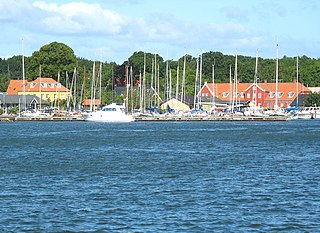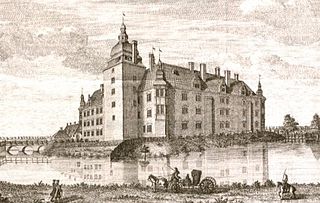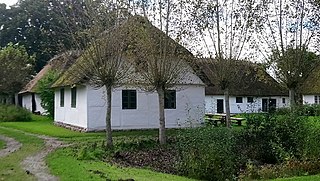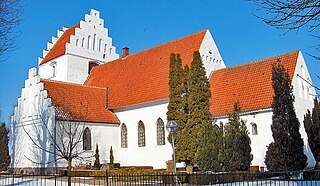
Nykøbing Falster is a southern Danish city, seat of the Guldborgsund kommune. It belongs to Region Sjælland. The city lies on Falster, connected by the 295-meter-long Frederick IX Bridge over the Guldborgsund waterway to the island of Lolland. The town has a population of 16,911. Including the satellite town Sundby on the Lolland side, with a population of 3,065 the total population is 19,976.

Falster is an island in south-eastern Denmark with an area of 486.2 km2 (187.7 sq mi) and 43,398 inhabitants as of 1 January 2010. Located in the Baltic sea, it is part of Region Zealand and is administered by Guldborgsund Municipality. Falster includes Denmark's southernmost point, Gedser Odde, near Gedser.

Guldborgsund is a municipality in Region Sjælland in Denmark, created on 1 January 2007 from six (6) former municipalities on the two islands Lolland in the west and Falster in the east bordering the Guldborgsund strait. It covers an area of 903.15 km² (2013) and has a total population of 61,219. Its neighboring municipalities are Lolland to the west and Vordingborg to the north. Its administrative seat is in the town of Nykøbing Falster. Its mayor as of 1 January 2022 is Simon Hansen, representing the Social Democrats.

Guldborgsund is the strait between the Danish islands of Lolland and Falster. It connects Smålandsfarvandet in the north with the Bay of Mecklenburg in the south. The strait is about 30 kilometers long; its breadth varies from 150 meters at Guldborg to 6 kilometer south of Nykøbing Falster. It is navigable for craft of up to 6 metres draught in its northern part and is used for commercial traffic to Nykøbing Falster. The southern part is much shallower with a minimum depth of approximately 2 metres, and can only be used by yachts and other small craft.
The Annals of Lund is a Latin set of annals written in Lund around 1250–1307. Several manuscript copies have survived to the modern day. The text is composed of two parts: the first part is based on earlier works, including the Chronicon Lethrense, and discusses events from antiquity to 1256; the second part includes events from every year until 1307. This portion is unique to the Annals of Lund and primarily deals with Danish politics. The topics include the Norwegian King Erik’s offensive in Denmark and Erik Menved's marriage with Ingeborg of Sweden in 1296. Additionally, the Battle of Gestilren in Sweden in 1210 and the 1256 destruction of Refshaleborg fort on Lolland are described.

Middelaldercentret is an experimental living history archaeological open-air museum in Denmark, which depicts the middle ages in the Denmark of the late 14th and early 15th centuries. It is located in Sundby Lolland, some 4 km northwest of the centre of Nykøbing Falster on the waterfront of Guldborgsund.

Danish National Archives is the national archive system of Denmark. The primary purpose is to collect, preserve and archive historically valuable records from central authorities, such as ministries, agencies and national organisations and make them available to the public. The archive is part of the Ministry of Culture.

Lolland is the fourth largest island of Denmark, with an area of 1,243 km2 (480 sq mi). Located in the Baltic Sea, it is part of Region Sjælland. As of 1 January 2022, it has 57,618 inhabitants.

Eskilstrup is a town some 12 kilometres (7.5 mi) north of Nykøbing Falster on the Danish island of Falster. As of 2022, it had a population of 1,066.

Ejegod Windmill is a smock mill located in the north of Nykøbing on the Danish island of Falster. The exterior has recently been fully restored. A toy museum was established within the old mill house in recent years.

Guldborg is a fishing village spanning the islands of Falster and Lolland in Denmark. It belongs to Guldborgsund Municipality, in Region Zealand. In 2022 the village had a population of 536, with about 500 living on the Lolland side. The village is located at the narrowest point between the two islands where Guldborg Bridge crosses Guldborgsund Sound.

Nykøbing Castle, now demolished, was located on today's Slotsbryggen in Nykøbing Falster, Denmark. Completed in 1594 in the Renaissance style, it replaced an earlier building from the 12th century. A royal palace, it was the traditional residence of Denmark's queen dowagers including Margrethe Sambiria (1230?–1282) and Queen Sophie (1557–1631). Christopher II died in the castle in 1332.

Torkilstrup Windmill is a post mill south of the village of Torkilstrup on the Danish island of Falster. Dating from 1743, it is one of the country's few post mills which still stand on their original site. It was listed in the Danish registry of protected buildings and places in 1959.

Falsters Minder is the city museum of Nykøbing on the Danish island of Falster. It is housed in the 17th century half-timbered building known as Czarens Hus.
Rasmus Sigvardt was a mechanic from Orehoved on the Danish island of Falster. In 1904, he opened a cycle repair shop which later developed into an engine factory, specializing in boat motors and mechanized fruit-tree sprayers.

Maribo Open-Air Museum is a museum located on the western outskirts of Maribo on the Danish island of Lolland. It is located 1 kilometre (0.62 mi) from Torvet, to the west of the Maribo Sø Camping site and oak woodland, near the northern banks of Søndersø Lake. It is the third oldest open-air museum in Denmark, and is in the backdrop of the Maribo Lakes Nature Park. Located on Meinckesvej, Maribo, the museum is open to visitors from 1 May to 30 September every day except Monday from 10 am to 4 pm.
Stiftsmuseum Maribo, also known as the Maribo County Museum, is a museum located in the centre of Maribo on the Danish island of Lolland. Its archeological and cultural heritage collections are housed in a specially designed building completed in 1890. Currently the exhibits include rustic furniture from Toreby, a variety of old clocks and the Maribo book collection consisting of some 2,000 volumes. There is also a complete set of the 18th-century Flora Danica illustrations of plants and flowers.

Hunseby is a village located some 3 km (1.9 mi) north of Maribo on the Danish island of Lolland. It belongs to Lolland Municipality in Region Sjælland. As of 2022, it has a population of 396.
Roedvig (Rødvig) Shipmotor Museum is located in Rødvig on Zealand, Denmark. It is one of several technical museums in Denmark. The museum was started in 1987. As of 2013 the museum has a collection of approximately 400 different engines, produced mostly by now defunct Danish factories over the period 1898 to 1974. The engines range in size from small outboards up to one German MTU medium-sized diesel of 2 000 hp.

Pederstrup is a historic manor house located 12 km (7.5 mi) north of Nakskov on the Danish island of Lolland. The half-timbered building from 1686 was rebuilt from 1813 to 1822 in the Neoclassical style by the statesman Christian Ditlev Frederik Reventlow. Since 1940, it has housed the Reventlow Museum.


















